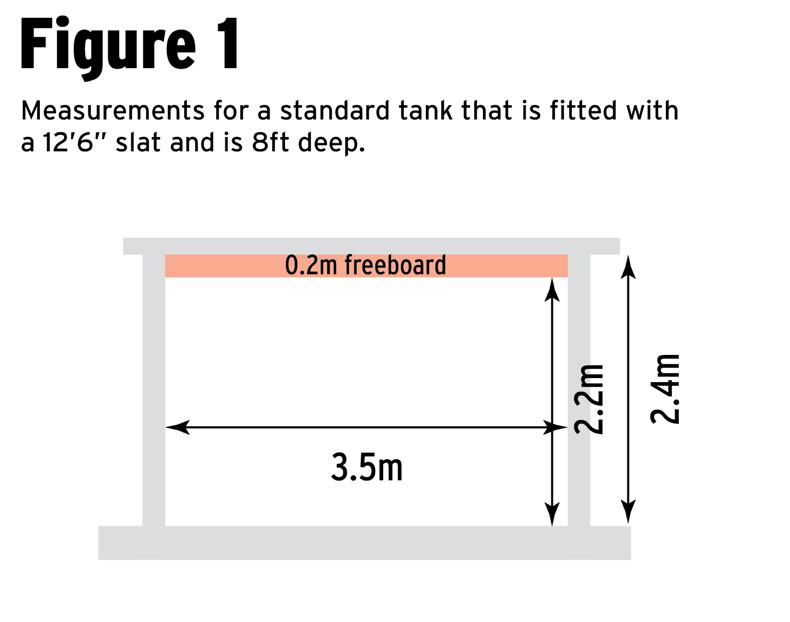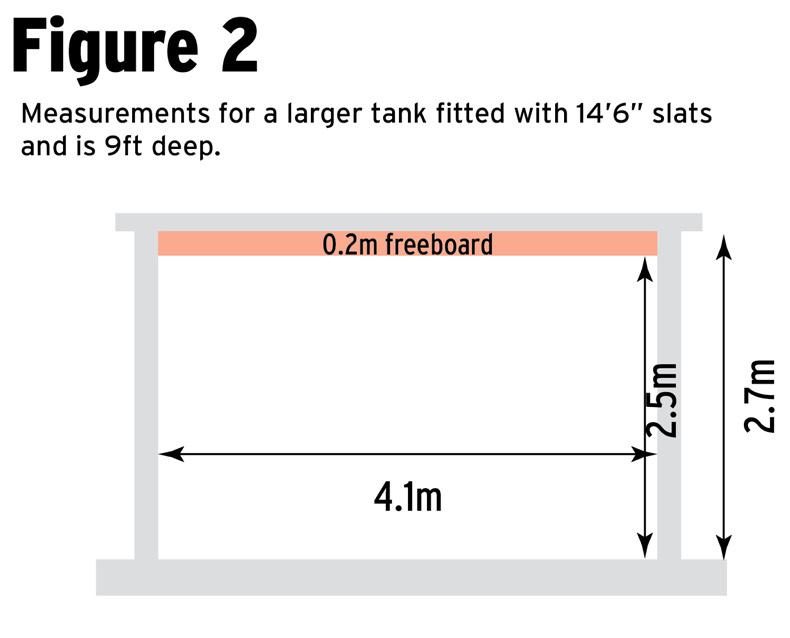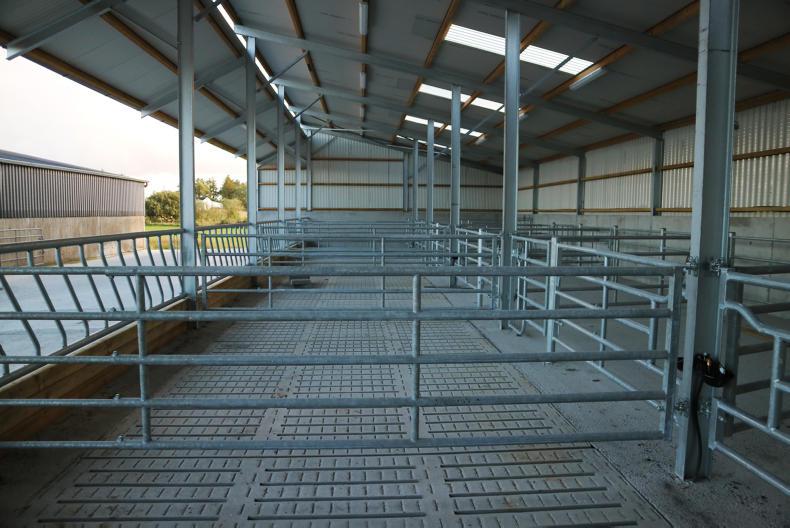In last week’s paper we went through how to calculate the slurry storage requirement for your farm. This week we will look at calculating how much storage you have available and how out-wintering stock may be used to reduce the required capacity.
Apart from out-wintering, farmers also have other ways that they can reduce the storage capacity required in line with nitrates regulations by having one of three contracts.
These include a contract giving you, and no one else, access to enough storage somewhere else, outside of your holding. A contract with a treatment facility for processing livestock manure will also suffice. Finally, a contract with an authorised person or body who undertakes the collection, recovery or disposal of waste can also be used to reduce the slurry storage requirement.
It is important to note that when you are calculating slurry storage available in tanks that you take into account free space at the top of the tank which must always be left, this is known as freeboard. Nitrates regulations require you to leave 200mm freeboard in all covered tanks when calculating capacity.
For example if a tank is 2.4m (8ft) deep, then for slurry storage calculations a depth of 2.2m would be used as seen in Figure 1.



When it comes to uncovered tanks, then freeboard of 300mm is required.
Calculating available storage
To calculate the storage capacity of a tank you will need to know the interior length, depth and width of the tank. What will put many farmers off calculating their available storage is not having plans of the shed to hand.
However, in general, the majority of covered, slatted tanks will be either 2.4m (8ft) or 2.7m (9ft) deep. So if we take the 200mm freeboard required for a covered tank, for calculation purposes, a 2.4m tank becomes 2.2m and a 2.7m deep tank becomes 2.5m deep.
Again, the vast majority of tanks would either be fitted with a 12’6” slat which is 3.81m long. Slats are required to have a full bearing on each wall of 150mm which would mean the interior width of the tank fitted with 12’6” slats is 3.5m, this is the figure we would use to calculate the capacity.
For a tank fitted with 14’6” slats, the interior width of the tank would be 4.1m. A tank fitted with 16’6” slats would have an interior width of 4.7m.
As the majority of farmers will know the size of the slats on the tank and the depth, all they need to calculate is the length of the shed to get their total slurry storage. A standard bay of a shed measures 4.8m so a four-bay shed, for example would have a tank that measures 19.2m.
However, if there are external agitation points this also needs to be considered. According to Department specifications, a tank must extend at least 1.2m (recommended 1.5m) beyond the end of the building to allow for an agitation point to be installed.
So for calculation purposes we would use the lower of the two, 1.2m. This would then give a total length of a four-bay tank of 21.6m. If the tank is more than 16m, or three 4.8m bays long then it is required to have external agitation points at either end of the shed.
Example
With all dimensions known we can calculate the storage capacity of the tank. A four-bay shed fitted with 12’6” slats on an 8ft deep tank, as seen in Figure 1, with two external agitation points would have a total capacity of 166.3m3, the workings for this example are outlined in Table 1.
If this shed was located in Zone B of the country where 18 weeks of slurry storage is required then it would accommodate the slurry produced by 32 suckler cows over the housing period (166.3m3 ÷ 0.29m3 per suckler cow per week ÷ 18 weeks = storage capacity for 32 cows).
If this shed was located in an area where only 16 weeks storage is required it could accommodate the slurry produced by 36 cows as per the nitrates regulations.
Table 1 can be used to calculate the capacity of your own tank.
Uncovered tanks
Over the past few years more and more farmers have put in uncovered tanks as a way of increasing slurry storage capacity in a cost efficient manner. Figure 3 shows that while these tanks may provide a large area of storage, if we take a 3m-deep tank, almost 30% of the capacity will be lost to rainfall and freeboard requirement of 300mm.
This is based on an uncovered tank in Cork where 37mm of rainfall falls per week over a 16-week period giving a total rainfall of 592mm. There is also the extra cost involved in spreading the increased volume of slurry that will be produced.
Overground circular tanks will also generally be uncovered. To calculate the capacity of a circular multiply pi (3.14) by the radius squared by the height.
Again, freeboard of 300mm and rainfall must also be accounted for.
Reducing demand with out-wintering
Out-wintering livestock is also an option to reduce slurry storage demands. A large amount of forage crops have been sown this year to combat any potential fodder shortage and this is an option that is becoming more popular, especially for younger stock. Full slurry storage is still required for all dairy cows on the farm.
The practical aspect of out-wintering needs to be seriously considered as for a lot of farmers land type will mean it is not an option. To be eligible to out-winter livestock, the total amount of livestock manure produced on your holding must not be more than 140kg of nitrogen per hectare.
If livestock are out-wintered at any period during the prohibited spreading periods, you may need less storage capacity. If you have sheep out-wintered they must not be stocked at more than 130kg of nitrogen to the hectare, this equates to 10 lowland ewes to the hectare.
This rule also applies if you have cattle, excluding dairy cows, out-wintered at a grassland stocking rate not exceeding 85kg of nitrogen to the hectare.
A suckler cow has an excretion of 65kg of nitrogen/year which means they could be stocked at 1.3 cows/ha or 13 cows over 10ha for example. Young cattle that are 0-1 year old have an excretion of 24kg of nitrogen/year meaning they could be stocked at 3.5 young cattle/ha or 35 weanlings on 10ha for example.
Older cattle that are 1-2 years old have an excretion of 57kg of nitrogen/year. This means that this age cattle could be out-wintered at a stocking rate of 1.5 cattle/ha or 15 1-2 year old cattle on 10ha.
If using this rule to reduce slurry storage requirements then it is important to note that all lands used for out-wintering must be part of your holding and the out-wintered stock must have free access at all times to the required land.
There must be no severe poaching on the land where out-wintering occurs. You should choose to out-winter on fields that will dry out quickly and do not have an extreme slope.
As seen over the past 12 months, being short on slurry storage facilities can add a lot of pressure and stress on any farmer if conditions are difficult in the spring.
A lot of silage has been made over the past week and with ground conditions still relatively good these fields could be targeted with slurry in order to empty tanks as soon as possible, especially on farms that could be under pressure if there is a difficult spring.






 This is a subscriber-only article
This is a subscriber-only article









SHARING OPTIONS: